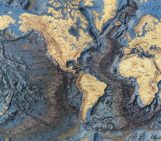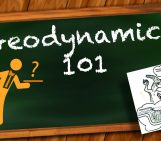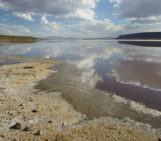
Understanding the plate tectonics initiation can give us incredible opportunity to guess the physical state of the early Earth. This week, Hee Choi, a Ph.D. candidate, takes us on a journey on initiation of plate tectonics and how continental crustal growth is related to it.
 Our planet Earth is the only place where plate tectonics takes place. No other planet or rocky moon in our solar system has plate tectonics. Scientists believe that plate tectonics was occurring at some time on the Earth’s twin planet, Venus. However, the details of when or why it stopped are unclear. The quest to understand the uniqueness of plate tectonics on Earth has been ongoing for decades. With the rapid advances in geoscience, we now understand better when and how plate tectonics initiated on the Earth. Here, we will discuss one of the feasible models for the plate tectonics initiation.
Our planet Earth is the only place where plate tectonics takes place. No other planet or rocky moon in our solar system has plate tectonics. Scientists believe that plate tectonics was occurring at some time on the Earth’s twin planet, Venus. However, the details of when or why it stopped are unclear. The quest to understand the uniqueness of plate tectonics on Earth has been ongoing for decades. With the rapid advances in geoscience, we now understand better when and how plate tectonics initiated on the Earth. Here, we will discuss one of the feasible models for the plate tectonics initiation.
Evidence of Plate tectonics in early Earth
The common agreement among geoscientists is that there was no plate tectonics in the beginning but rather during the early stages of Earth’s history. There are several geochemical and petrological evidence indicating Archean rocks which would form as a result of plate tectonics. The formation of the supercontinent requires the closure of multiple ocean basins, leading to the subduction of the oceanic lithosphere on a global scale. Consequently, sampling of ophiolites, crustal rocks on continental margins which were once part of the oceanic lithosphere, is a reliable indicator of plate tectonics. The presence of Blueschists and ultra-high-pressure (UHP) metamorphic rocks also indicate plate tectonics because a subduction zone provides the tectonic setting under which these rocks can form. Geochemical records of igneous rocks with arc-like chemical compositions can also be used to infer plate tectonics in early Earth. Changes in rare Earth element (REE) pattern or MgO % are additional evidence of plate tectonic operation.
With the wide quantity of evidence available, a range of onset times of plate tectonics initiation has been suggested. Using the geochemistry of Jack Hills Hadean zircons, Hopkins et al. (2010) proposed 4 Gyrs ago. Stern (2005) claimed that the modern style plate tectonics did not start on Earth until ~1 Gyr ago based on the absence of UHP metamorphism and ophiolites. Except for these two extreme cases, most of the studies point to Archean as an onset time of plate tectonics.
Plate tectonics initiation and continental crust growth
Surprisingly, the geochemical evidence also points to another process that was happening at the same time as the onset of plate tectonics – rapid continental growth on Earth (Hawkesworth et al., 2010; Dhuime et al., 2015). This makes one wonder if this is just a coincidence, or is there any correlation between two geological events? Some geologic records even support the idea that the primitive continental block acts as nuclei for subduction (Reimink et al., 2016).
Continental crust is chemically buoyant and has higher viscosity than the surrounding mantle. Due to the sharp viscosity jump between the surrounding mantle and continental crust, the stress can be focused on the continental margins and might result in more damage in the lithosphere. In other words, the presence of the continent can possibly lead to subduction and thus induce present-like subduction. Therefore, the role of continents in subduction initiation needs to be investigated to untangle the mystery of plate tectonics initiation.
Further Reading
Dhuime, B., Wuestefeld, A., & Hawkesworth, C. J. (2015). Emergence of modern continental crust about 3 billion years ago. Nature Geoscience, 8(7), 552-555. Hawkesworth, C. J., Dhuime, B., Pietranik, A. B., Cawood, P. A., Kemp, A. I., & Storey, C. D. (2010). The generation and evolution of the continental crust. Journal of the Geological Society, 167(2), 229-248. Hopkins, M. D., Harrison, T. M., & Manning, C. E. (2010). Constraints on Hadean geodynamics from mineral inclusions in> 4 Ga zircons. Earth and Planetary Science Letters, 298(3-4), 367-376. Reimink, J. R., Davies, J. H. F. L., Chacko, T., Stern, R. A., Heaman, L. M., Sarkar, C., ... & Pearson, D. G. (2016). No evidence for Hadean continental crust within Earth’s oldest evolved rock unit. Nature Geoscience, 9(10), 777-780. Stern, R. J. (2005). Evidence from ophiolites, blueschists, and ultrahigh-pressure metamorphic terranes that the modern episode of subduction tectonics began in Neoproterozoic time. Geology, 33(7), 557-560.




